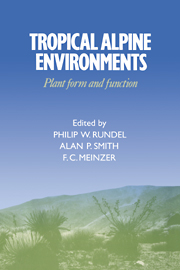Book contents
- Frontmatter
- Contents
- List of contributors
- Preface
- 1 Introduction to tropical alpine vegetation
- 2 Tropical alpine climates
- 3 Páramo microclimate and leaf thermal balance of Andean giant rosette plants
- 4 Comparative water relations of tropical alpine plants
- 5 Cold tolerance in tropical alpine plants
- 6 Anatomy of tropical alpine plants
- 7 Environmental biology of a tropical treeline species, Polylepis sericea
- 8 Morphological and physiological radiation in páramo Draba
- 9 Sediment-based carbon nutrition in tropical alpine Isoetes
- 10 Functional significance of inflorescence pubescence in tropical alpine species of Puya
- 11 Turnover and conservation of nutrients in the pachycaul Senecio keniodendron
- 12 Soil nutrient dynamics in East African alpine ecosystems
- 13 An overview of the reproductive biology of Espeletia (Asteraceae) in the Venezuelan Andes
- 14 Population biology of Mount Kenya lobelias
- 15 Population biology of Senecio keniodendron (Asteraceae), an Afroalpine giant rosette plant
- 16 Population dynamics and flowering in a Hawaiian alpine rosette plant, Argyroxiphium sandwicense
- 17 Plant form and function in alpine New Guinea
- 18 Alpine herbivory on Mount Kenya
- 19 Biotic interactions in Hawaiian high elevation ecosystems
- 20 Tropical alpine ecology: progress and priorities
- Index
9 - Sediment-based carbon nutrition in tropical alpine Isoetes
Published online by Cambridge University Press: 21 October 2009
- Frontmatter
- Contents
- List of contributors
- Preface
- 1 Introduction to tropical alpine vegetation
- 2 Tropical alpine climates
- 3 Páramo microclimate and leaf thermal balance of Andean giant rosette plants
- 4 Comparative water relations of tropical alpine plants
- 5 Cold tolerance in tropical alpine plants
- 6 Anatomy of tropical alpine plants
- 7 Environmental biology of a tropical treeline species, Polylepis sericea
- 8 Morphological and physiological radiation in páramo Draba
- 9 Sediment-based carbon nutrition in tropical alpine Isoetes
- 10 Functional significance of inflorescence pubescence in tropical alpine species of Puya
- 11 Turnover and conservation of nutrients in the pachycaul Senecio keniodendron
- 12 Soil nutrient dynamics in East African alpine ecosystems
- 13 An overview of the reproductive biology of Espeletia (Asteraceae) in the Venezuelan Andes
- 14 Population biology of Mount Kenya lobelias
- 15 Population biology of Senecio keniodendron (Asteraceae), an Afroalpine giant rosette plant
- 16 Population dynamics and flowering in a Hawaiian alpine rosette plant, Argyroxiphium sandwicense
- 17 Plant form and function in alpine New Guinea
- 18 Alpine herbivory on Mount Kenya
- 19 Biotic interactions in Hawaiian high elevation ecosystems
- 20 Tropical alpine ecology: progress and priorities
- Index
Summary
Introduction
Isoetes (Isoetaceae) is a genus of small herbaceous plants often aligned with Lycopodium and Selaginella. There are more than 150 species distributed worldwide, typically in aquatic habitats (Tryon & Tryon 1982). A particularly intriguing aspect of the physiology of these plants is the presence of Crassulacean Acid Metabolism (CAM) (Keeley 1981, 1982), a photosynthetic pathway commonly associated with terrestrial xerophytes. CAM was selected for in these species by the daytime carbon limitation characteristic of their oligotrophic aquatic habitats (Keeley & Busch 1984; Boston & Adams 1985).
Across its range, Isoetes has radiated into a variety of aquatic as well as some terrestrial habitats and these environments have selected for a number of different structural-functional syndromes (Keeley 1987). Aquatic species occur in lacustrine habitats where they are permanently submerged throughout their life cycle and in amphibious environments where they alternate seasonally between aquatic and terrestrial conditions. In general, all aquatic species so far tested possess a well-developed CAM pathway while under water but lose this pathway when grown in an aerial environment. True terrestrial species of Isoetes are few in number although such species are known from most parts of the world. They readily fall into one of two groups: vernally active, summer-deciduous species at relatively low elevations in temperate latitudes; and evergreen species restricted to very high elevations (> 3500 m) in tropical latitudes. The former species show no CAM activity (even if artificially submerged), possess stomata and presumably depend entirely on C3 photosynthesis.
- Type
- Chapter
- Information
- Tropical Alpine EnvironmentsPlant Form and Function, pp. 167 - 194Publisher: Cambridge University PressPrint publication year: 1994
- 11
- Cited by

